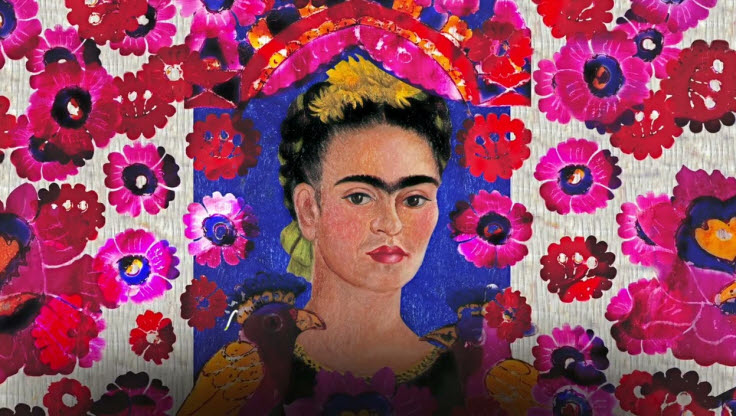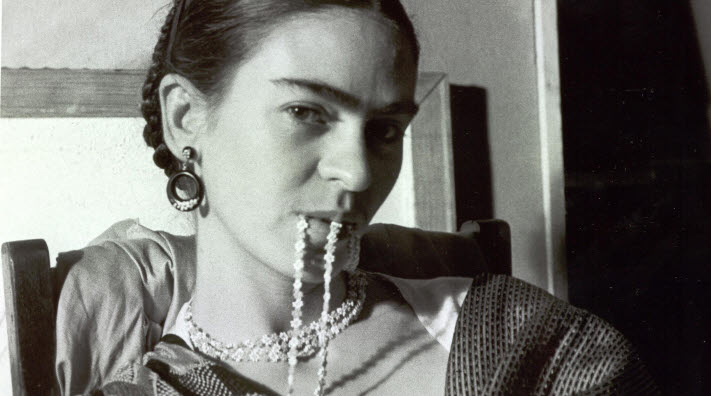Documentary film “Frida”, which is currently available on Amazon Prime, presents the life and career of legendary Mexican artist Frida Kahlo mainly via her works and words. Although it may not inform you that much if you are familiar with its main subject, the documentary is still a fairly interesting presentation of Kahlo’s life and career, and you may want to check out more of her works after watching it.
The narrative flow of the documentary is mainly driven by the excerpts from Kahlo’s personal letters and diaries, which are narrated by Fernanda Echevarría. Director/co-editor Carla Gutierrez frequently juxtaposes the narration of her documentary with a number of various visual elements ranging from archival photographs and footage clips to the colorful animations based on many of Kahlo’s works, and we are accordingly served with a kaleidoscopically vibrant portrayal of her immense personality and talent.
At the beginning, the documentary gives us a brief summary on Kahlo’s early years. Mainly influenced by her photographer father who had lots of artistic sensibility besides being quite sophisticated, young Kahlo showed rebellious streaks even during her childhood years, and this tendency of hers only grew much more when she later went to a prep school for studying to become a doctor. As she and several other classmates of hers tell us, she was your average wild rebel who did not give much damn about any social rule or convention, and that aspect of hers is quite evident from a photograph showing her confidently wearing a male suit. Not so surprisingly, she later became a staunch socialist just like her friends and colleagues, and she certainly stuck to her strong political belief to the end.
However, Kahlo happened to have a devastating traffic accident when she was 18, and her consequent physical injury became a personal demon which haunted her throughout the rest of her life. While quite frustrated with being much less physically active than before, Kahlo came to pay more attention to her artistic passion as going through her following recuperation period, and that was the beginning of her artistic career.
Around that time, Kahlo approached to Diego Rivera, a prominent Mexican artist who was quite famous for a number of murals where he boldly mixed his artistic ambition and political belief. When he was approached by Kahlo, Rivera was instantly attracted to Kahlo’s spirit and talent, and it did not take much time for him to get romantically involved with her. When he eventually proposed to her later, Kahlo did not hesitate because she was deeply in love with him despite knowing well how promiscuous he had been – how unfaithful he would be even after their wedding.
Anyway, things went fairly well between them during next several years thanks to their mutual understanding on Rivera’s frequently infidelity. When Rivera was invited to US around the early 1930s, Kahlo went along with her to New York City, and she focused more on developing her own artistic field while her husband was often more occupied with a series of ambitious artistic projects. However, she eventually got tired of being in New York City and other American cities, as often discerning the superficial hypocrisy of those rich members of the American high society.
In the end, Rivera and Kahlo returned to Mexico after his infamous mural at the Rockefeller Center of New York City was canceled due to his blatant political touch, and then their marital relationship got gradually deteriorated as they became more distant to each other. While Rivera committed more infidelity here and there, Kahlo also got romantically involved with a bunch of different women and men including Leon Trotsky, and Rivera often could not help but become jealous even though they agreed on their open relationship from the beginning.
When Rivera did something almost unforgivable to her, Kahlo came to decide that enough is enough. After her eventual divorce, she went on her own artistic way as she always wanted, and the documentary naturally provides us several striking visual moments via the animation presentation of several works of hers during that period. Thanks to a French artist friend of hers, her works came to draw lots of attention in both New York City and Paris, and she also received some praises from many prominent artists including Pablo Picasso and Joan Miró. While she was regarded as a part of the surrealism movement during the 20th century, she was not pleased with being categorized like that, and she also had a strong negative opinion on how art was often almost monopolized by male artists who never regarded her as their equal.
The main weak point of the documentary is its rather deficient last part involved with the last years of Kahlo’s life and career. Considering how she somehow kept moving on despite her declining physical status, this part should be quite poignant and harrowing to say the least, but the documentary often seems to scratch the surface instead of fully delving into Kahlo’s painful later years, and that is a bit disappointing in my humble opinion.
In conclusion, “Frida” is not entirely without flaws, but I enjoyed its vivid and colorful visual presentation of Kahlo’s life and career at least, and it is certainly recommendable if you only vaguely know about her works. She was indeed a trailblazing artist who surely deserves all the acclaims and praises upon her many distinctive works at present, and, considering a biting quote from her around the end of the documentary, she would quite be amused if she were alive now.










